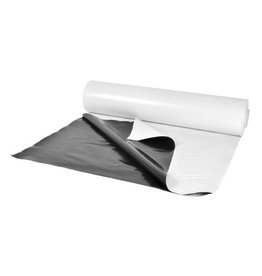Panda Brand Film
Panda™ film is recognized among the best brands of black and white poly film used in light deprivation applications. Countless people choose the Panda™ brand of poly products due to the level of performance found exclusively with Panda™ poly film. The Panda™ Premium® black and white poly film offered by Pro-Tect Plastics is 100% FDA compliant and comes with a non-prorated warranty and a quality assurance tracking system. Panda™ plastic consistently receives positive reviews and has a base of devoted fans who trust the Panda™ brand of black and white poly film.
Benefits
- Brilliant white layer ensures maximum light reflectivity to aid in vegetable crop production.
- Provides maximum control when used as a blackout curtain for your crops.
- Greenhouse blackout film reflects heat and cools better than shade cloth.
- This black and white poly film is designed specifically to withstand the wear and tear of either foot traffic or retractable curtain systems, so that crop management control is not reduced in these higher-stress applications.
- High strength at folds of the Panda film means higher resistance to punctures and tears. In any greenhouse plastic film, weaknesses can occur where the polymer strands are bent at a fold. Increased fold strength minimizes performance issues at these key areas.
As temperatures increase (45°C = 113°F), greenhouse films will expand. As temperatures decrease (-20°C = 4°F), the greenhouse poly films will contract. The amount of expansion and contraction is different in both length (machine direction) and width (transverse direction). Typically, dimensional changes of 1 to 12 inches in length and 1 to 4 inches in width can be expected under field conditions. The actual expansion and contraction will vary with differences in black and white poly film width, gauge, formulation, and manufacturing conditions. Allow for the normal expansion and contraction of the greenhouse blackout film during installation. Single layer greenhouse film should be installed snugly, but should not be overly tight. Avoid stretching the greenhouse blackout film during installation. Double poly film installations should provide enough slack in the top layer to allow 12” to 24” of inflation.
Black and white plastic sheeting is used in crop control management. The white side is highly reflective and used to direct light away. The black side is completely opaque and absorbs light, keeping heat and light away. It is also used for waterproofing and temperature control.
With Panda™ Premium® sheeting you get durability and control. Our 5 mil Panda™ paper is a highly reflective and opaque black and white poly film that can be used for ground cover, wall cover, roof cover, or as a blackout curtain for photoperiod control in a garden or indoor greenhouse. Available in a roll of 24 ft or 32 ft, Panda™ black and white plastic sheeting helps you control grow cycles and more.
Panda™ film can be used in a variety of ways.
● Line the floor or ballasts of your grow area, using the white side to reflect light from the floor up to crops and prevent weed and other unwanted growth with the black side.
● Prevent ground moisture from disturbing controlled humidity levels.
● Stop soil borne pathogens from rising up into the grow area.
● Control, contain, and direct runoff to available drains.
● Can be used to line the roof and walls of indoor growing areas for additional waterproofing, lighting, and temperature control.
There are numerous benefits to using Panda™ film over other brands. Panda™ film is designed specifically to withstand the wear and tear of high-stress applications. It stands up to repeated foot traffic and retractable curtain systems. Panda™ film has enough strength at folds so it has higher resistance to punctures and tears. Increased fold strength minimizes performance issues at these key areas in a Panda™ paper grow room.
If you set up a greenhouse for winter growing, you will have to make lighting adjustments. Total daylight hours are reduced in winter. The sun rises late and goes down early. During higher sun and longer daylight seasons, your crops may have thrived with a light filtration cover. Your greenhouse in winter may need a clear, maximum light greenhouse cover to get the most from the limited daylight.
Light deprivation covers may be worth exploring in your homemade greenhouse for winter. Light deprivation greenhouse cover has two sides: a white side to reflect light and a black side to absorb light. Harness and direct as much winter sunlight as possible by using the white side to reflect it from the walls and floors of your cold weather greenhouse back to your crops.
What crops can you grow in a greenhouse lined with Panda film? More than you might expect! Planting hardier, cold weather-tolerant edibles will lead to a more bountiful yield. In general, root vegetables and leafy greens grow well in a homemade greenhouse for winter. There are also a couple of other edibles that are surprisingly hardy in a winter greenhouse.
Top crop choices include:
● Lettuces such as romaine, butterhead, and leaf lettuce.
● Other salad greens like radicchio and arugula.
● Greens such as spinach, collards, mustard greens, kale, and chard.
● Green onion
● Cilantro
Growers tend to plant a crop and plan to harvest it at once at the end of a growing season. When using a greenhouse for winter growing, this doesn’t work as well. Growing cycles will vary from other seasons and may require several small harvests rather than one big one at the end of the season. For small farmers who sell at markets, this can be advantageous as they have something to offer customers throughout the season.
Edible gardening is not the only use for your greenhouse in a winter climate. There are many flowering and decorative plants that do well in a winter greenhouse, too. Having gorgeous blooms and fronds to care for can lift the winter blues and keep your greenhouse looking alive and well during the long, darker months. Some flowers that can thrive in a temperature-controlled greenhouse in winter include: Iris, Calla lilies, Freesia, Daffodils, Tulips, Hyacinth, and Orchids.



